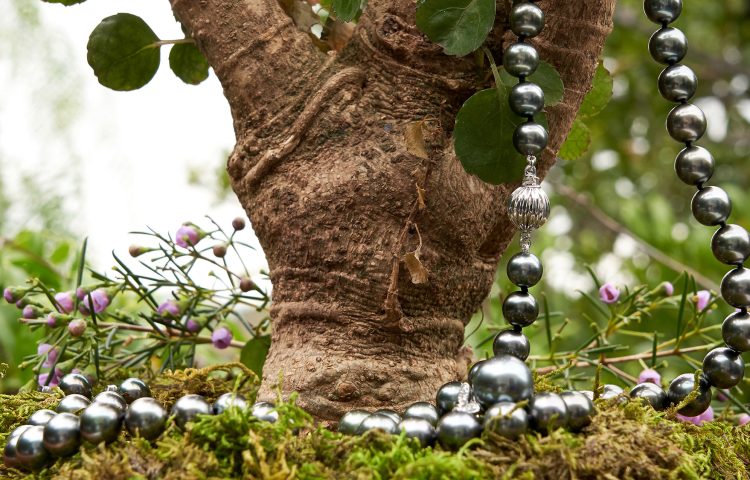Pearl surface quality is a critical determinant of a pearl’s value and beauty. When we talk about the surface quality of a pearl, we’re referring to the cleanliness of a pearl’s surface – specifically, the presence or absence of surface imperfections or blemishes such as spots, bumps, or scratches. A pearl’s surface can range from being perfectly smooth and clean to being heavily blemished. Learn more about pearl grading here.
The surface quality of Tahitian pearls is particularly important in the creation of jewelry like Tahitian pearl necklaces, earrings and bracelets. A high-quality Tahitian pearl will have few to no blemishes on the surface, which can allow the pearl’s radiant luster and unique color play to truly shine.
Factors Influencing the Surface Quality of Tahitian Pearls
Several factors can influence the surface quality of Tahitian pearls. The health of the oyster, the water conditions during the pearl’s cultivation period, and the length of time the pearl spends in the oyster can all impact the final appearance of the pearl’s surface.
Making an Educated Purchase: Importance of Understanding Pearl Grading
Understanding the grading system for Tahitian pearls is vital for making an educated purchase. This system evaluates pearls based on several factors, including size, Tahitian pearl shape, luster, and surface quality.
Learning to Assess the Surface of a Pearl
Knowing how to assess the surface of a Tahitian pearl can greatly assist in determining its quality and value. Pearls with smoother surfaces typically command higher prices. It’s also crucial to understand that no pearl is absolutely perfect; even the highest quality pearls will have some slight imperfections GIA.
Importance of Educated Purchase to Avoid Overpricing
Being familiar with Tahitian pearl grading helps avoid overpricing and ensure you get good value for your money. Given the variety of pearls on the market, having a solid understanding of what differentiates a high-quality Tahitian pearl from others will ensure you make a smart investment.
Tahitian Pearls Surface Categories

The surface of Tahitian pearls is classified into four major categories, from A to D, each representing a different level of surface quality.
Category A: Flawless and Perfectly Clean Pearls
Category A represents the highest quality, with the pearl surface being nearly flawless. Pearls in this category have a smooth and lustrous surface with very few, if any, visible imperfections.
Category B: Lightly Spotted Pearls
Pearls in category B have light spots or minor imperfections, which do not detract from their overall beauty or luster.
Category C: Moderately Flawed Pearls
Category C cultured Tahitian pearls pearls have moderate flaws and imperfections, but they still maintain a good level of luster and beauty.
Category D: Heavily Spotted or Blemished Pearls
Category D includes pearls with the most flaws, blemishes, or spots. These pearls have noticeable imperfections even from a distance.
Tahitian Pearl Surface Compared to Other Pearl Types
The surface of Tahitian pearls is distinctive, with a unique luster that reflects a spectrum of colors. This “peacock” effect, combined with their relative rarity, makes Tahitian pearls highly desirable.
Comparison with Freshwater Pearls
When compared to freshwater pearls, Tahitian pearls generally have a smoother and more lustrous surface. The thicker nacre of Tahitian pearls contributes to their superior luster and surface quality Pearls.com.
Comparison with Akoya Pearls
While Akoya pearls are renowned for their high luster and almost perfect round shape, the surface quality of Tahitian pearls is generally superior due to the longer cultivation period and thicker nacre.
Comparison with South Sea Pearls
South Sea pearls and Tahitian pearls are both cultivated in saltwater and have thick nacre layers. However, the warm waters of the South Seas allow for a faster build-up of the nacre, sometimes resulting in a slightly less smooth surface than Tahitian pearls.
How Tahitian Pearls Stand Out in the Pearl Market
In the world of pearls, Tahitian pearls stand out for their dark hues, high luster, and excellent surface quality. Their distinctive color spectrum, coupled with their relative rarity, makes them a unique and sought-after gem in the pearl market.
The surface of a Tahitian pearl, reflecting its journey from a mere grain of sand to a lustrous gem, holds a special allure. Understanding how this surface quality is categorized and evaluated not only allows for a deeper appreciation of these marine gems but also guides the discerning buyer in their selection process.
FAQs
The surface quality of a Tahitian pearl refers to the cleanliness of its surface, specifically the presence or absence of imperfections or blemishes such as spots, bumps, or scratches. Factors like the health of the oyster, water conditions during cultivation, and the time the pearl remains in the oyster can influence its final surface appearance.
Tahitian pearls are categorized based on their surface quality from A to D. Category A pearls are nearly flawless, Category B pearls have light spots, Category C pearls display moderate flaws, and Category D pearls have the most noticeable blemishes and imperfections.
Tahitian pearls are distinctive for their high luster and smooth surface, reflecting a range of colors. Compared to freshwater pearls, they generally have a smoother surface due to their thicker nacre. While Akoya pearls are known for their high luster, the surface quality of Tahitian pearls is often superior because of the longer cultivation period. In comparison to South Sea pearls, Tahitians might have a smoother surface since the warm South Seas waters can sometimes result in a faster, but slightly less smooth, nacre build-up.

JEWELRY SPOTLIGHT
Dive into the enchanting world of Tahitian Pearl Jewelry. Adorn yourself with nature’s finest pearls, each selected for its unique allure and captivating color palette. Whether you choose a timeless classic or a modern masterpiece, our collection offers a blend of sophistication and natural elegance. Elevate your style or gift a touch of radiance to someone special.

